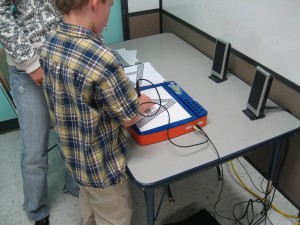Designers: Elliot Greenwald and David Zilber
Client Coordinator: Chris Wensil, Mariposa School for Children with Autism
INTRODUCTION:
The ability to write is a skill that is essential for natural progression in an academic setting. However, for children with autism, traditional methods for developing this skill are less effective. Typically, the precursor to writing is the development of fine motor control within the dominant hand, and this can be accomplished via tracing. Even with the one-on-one, personalized instruction and positive reinforcement offered at The Mariposa School, a school for children with autism in Cary, North Carolina, most of their students are not motivated to develop tracing and handwriting skills. The goal of the project was to develop an aid that provides positive feedback when the student is tracing properly over large, printed letters.
SUMMARY OF IMPACT
Our client coordinator at The Mariposa School, Chris Wensil, is excited about the device and its ability to help many children at the school. In particular, he is impressed with the device’s immediate impact with several children; they quickly learned that proper tracing keeps the music playing and thus they should continue to practice a proper tracing technique.
TECHNICAL DESCRIPTION
The purpose of the device is to provide musical feedback when the child is tracing properly. A photodiode sensor is mounted in the tip of a pen, and the client uses this pen to trace over a piece of paper with a large printed letter (see figure 1). The paper rests on top of a commercial light-bed. Light shines up from the bed, through the paper and the light level is detected by the photodiode sensor. When the sensor is over a dark area on the page, the black ink on the paper blocks a significant amount of light, resulting in a low voltage output from the photodiode. Accordingly, when the sensor is over a blank area on the page, more light reaches the photodiode sensor and its output voltage increases.
If the desired tracing area on the page is solid black, then the device cannot differentiate between a moving pen and a stationary pen positioned over the black areas on the page, because both scenarios would result in a low voltage on the photodiode. In addition, low light levels within the ambient environment will provide similar signals as the black tracing area. A simple solution is to make the tracing area consist of a checkerboard pattern (note the “A” on figure 1). As a result, when the user is properly tracing over the checkerboard, the photodiode signal is roughly sinusoidal. The microcontroller looks for a sinusoidal signal of a certain minimum frequency, and triggers the musical feedback accordingly.
All calculations are performed with a PIC 16F876 microcontroller (Microchip, Inc., Chandler AZ), which receives input from a simple photodiode embedded within a pen. When the proper signal is received, the microcontroller commands a Rogue Robotics uMP3 board (Toronto ON) to play an MP3 file, which is stored on an easily accessible Secure Digital (SD) card. The device is built into a commercially available children’s tracing toy, the Elmer’s Paintastics Light Magic. The pen housing is custom built with the use of a rapid-prototyping fusion deposition modeler and other widely available parts. The inking cartridge is from a commercial BIC ballpoint pen, and it fits snugly into the custom pen housing. The teachers can easily replace the cartridge when necessary. The pen connects to the circuitry via a cable and 3.5 mm audio stereo plugs. Commercial, external speakers or headphones provide the audio feedback.
Once the Trace-Aid is activated by toggling the main power switch, the user can immediately begin tracing. As long as the pen is moved over the designated tracing area, music will be heard from an audio output. However, as soon as the pen leaves the desired tracing area, or the child stops moving the pen, then the music abruptly stops. In the event that the child completes a tracing session with satisfactory results, the instructor may opt to provide an additional reward by playing continuous music. This is accomplished via a “reward” switch, activated by the instructor when appropriate.
The device is battery powered, large enough to accommodate a standard 8 ½” x 11” piece of paper, yet portable enough to fit on a wheelchair lap tray. The total cost of the device was $205.




University Operator: (919) 962-2211 | © 2024 The University of North Carolina at Chapel Hill |